Quotations | Newspaper
Articles | Special Features | Links | Search
SPECIAL FEATURE
"Instructions in Art"
(With Illustrations by the Author)
First published in Metropolitan Magazine (April and May 1903).
The great trouble about painting a whole gallery of portraits at the same time is, that the housemaid comes and dusts, and does not put them back the way they were before, and so when the public flock to the studio and wish to know which is Howells and which is Depew and so on, you have to dissemble, and it is very embarrassing at first. Still, you know they are there, and this knowledge presently gives you more or less confidence, and you say sternly, "This is Howells," and watch the visitor's eye. If you see doubt there, you correct yourself and try another. In time you find one that will satisfy, and then you feel relief and joy, but you have suffered much in the meantime; and you know that this joy is only temporary, for the next inquirer will settle on another Howells of a quite different aspect, and one which you suspect is Edward VII or Cromwell, though you keep that to yourself, of course. It is much better to label a portrait when you first paint it, then there is no uncertainty in your mind and you can get bets out of the visitor and win them.
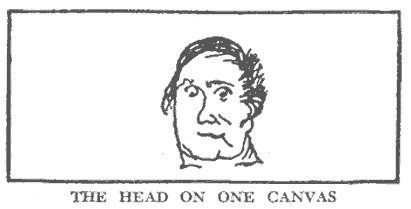
I believe I have had the most trouble with a portrait which I painted in installments -- the head on one canvas and the bust on another.
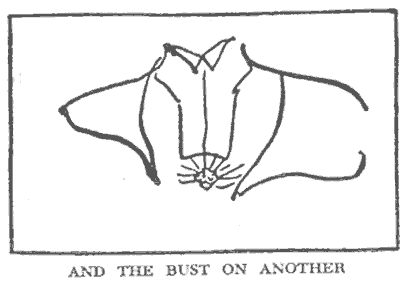
The housemaid stood the bust up sideways, and now I don't know which way it goes. Some authorities think it belongs with the breastpin at the top, under the man's chin; others think it belongs the reverse way, on account of the collar, one of these saying, "A person can wear a breastpin on his stomach if he wants to, but he can't wear his collar anywhere he dern pleases." There is a certain amount of sense in that view of it. Still, there is no way to determine the matter for certain; when you join the installments, with the pin under the chin, that seems to be right; then when you reverse it and bring the collar under the chin it seems as right as ever; whichever way you fix it the lines come together snug and convincing, and either way you do it the portrait's face looks equally surprised and rejoiced, and as if it wouldn't be satisfied to have it any way but just that one; in fact, even if you take the bust away altogether the face seems surprised and happy just the same -- I have never seen an expression before, which no vicissitudes could alter. I wish I could remember who it is. It looks a little like Washington, but I do not think it can be Washington, because he had as many ears on one side as the other. You can always tell Washington by that; he was very particular about his ears, and about having them arranged the same old way all the time.
By and by I shall get out of these confusions, and then it will be plain sailing; but first-off the confusions were natural and not to be avoided. My reputation came very suddenly and tumultuously when I published my own portrait, and it turned my head a little, for indeed there was never anything like it. In a single day I got orders from sixty-two people not to paint their portraits, some of them the most distinguished persons in the country -- the President, the Cabinet, authors, governors, admirals, candidates for office on the weak side -- almost everybody that was anybody, and it would really have turned the head of nearly any beginner to get so much notice and have it come with such a frenzy of cordiality. But I am growing calm and settling down to business, now; and pretty soon I shall cease to be flurried, and then when I do a portrait I shall be quite at myself and able on the instant to tell it from the others and pick it out when wanted.
I am living a new and exalted life of late. It steeps me in a sacred rapture to see a portrait develop and take soul under my hand. First, I throw off a study -- just a mere study, a few apparently random lines -- and to look at it you would hardly ever suspect who it was going to be; even I cannot tell, myself. Take this picture, for instance:
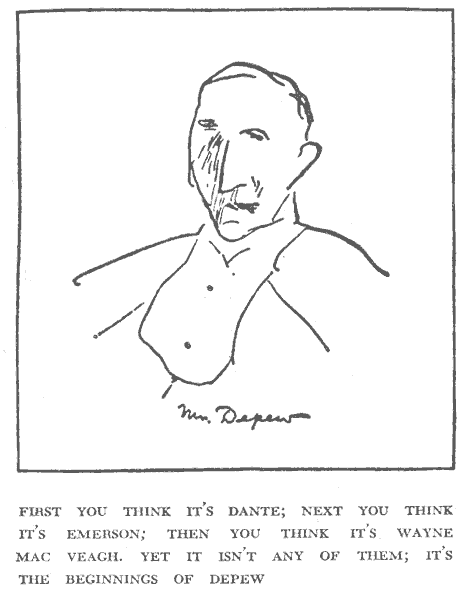
First you think it's Dante; next you think it's Emerson; then you think it's Wayne MacVeagh. Yet it isn't any of them; it's the beginnings of Depew. Now you wouldn't believe Depew could be devolved out of that; yet the minute it is finished here you have him to the life, and you say, yourself, "If that isn't Depew it isn't anybody."
Some would have painted him speaking, but he isn't always speaking, he has to stop and think sometimes.
That is a genre picture, as we say in the trade, and differs from the encaustic and other schools in various ways, mainly technical, which you wouldn't understand if I should explain them to you. But you will get the idea as I go along, and little by little you will learn all that is valuable about Art without knowing how it happened, and without any sense of strain or effort, and then you will know what school a picture belongs to, just at a glance, and whether it is an animal picture or a landscape. It is then that the joy of life will begin for you.
When you come to examine my portraits of Mr. Joe Jefferson and the rest, your eye will have become measurably educated by that time, and you will recognize at once that no two of them are alike. I will close the present chapter with an example of the nude, for your instruction.
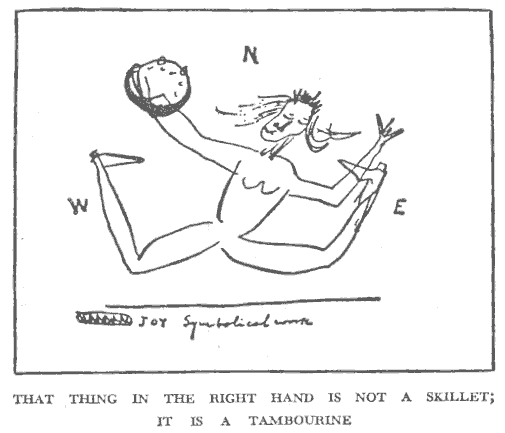
This creation is different from any of the other works. The others are from real life, but this is an example of still-life; so called because it is a portrayal of a fancy only, a thing which has no actual and active existence. The purpose of a still-life picture is to concrete to the eye the spiritual, the intangible, a something which we feel, but cannot see with the fleshy vision -- such as joy, sorrow, resentment, and so on. This is best achieved by the employment of that treatment which we call the impressionist, in the trade. The present example is an impressionist picture, done in distemper, with a chiaroscuro motif modified by monochromatic technique, so as to secure tenderness of feeling and spirituality of expression. At a first glance it would seem to be a Botticelli, but it is not that; it is only a humble imitation of that great master of longness and slimness and limbfulness.
The work is imagined from Greek story, and represents Proserpine or Persepolis, or one of those other Bacchantes doing the solemnities of welcome before the altar of Isis upon the arrival of the annual shipload of Athenian youths in the island of Minos to be sacrificed in appeasement of the Dordonian Cyclops.
The figure symbolizes solemn joy. It is severely Greek, therefore does not call details of drapery or other factitious helps to its aid, but depends wholly upon grace of action and symmetry of contour for its effects. It is intended to be viewed from the south or southeast, and I think that that is best; for while it expresses more and larger joy when viewed from the east or the north, the features of the face are too much foreshortened and wormy when viewed from that point. That thing in the right hand is not a skillet; it is a tambourine.
This creation will be exhibited at the Paris Salon in June, and will compete for the Prix de Rome.
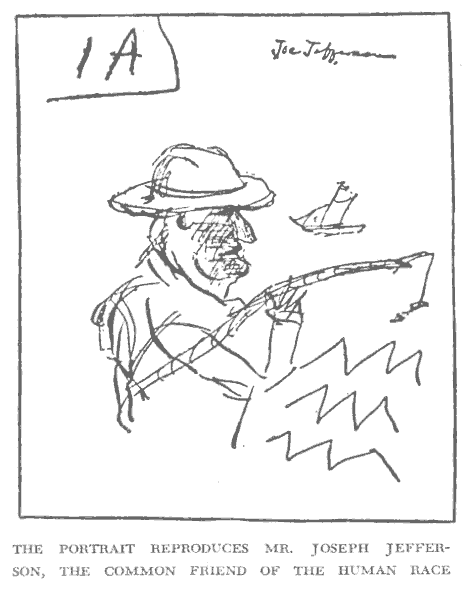
The above is a marine picture, and is intended to educate the eye in the important matters of perspective and foreshortening. The mountainous and bounding waves in the foreground, contrasted with the tranquil ship fading away as in a dream the other side of the fishing-pole, convey to us the idea of space and distance as no words could do. Such is the miracle wrought by that wondrous device, perspective.
The portrait reproduces Mr. Joseph Jefferson, the common friend of the human race. He is fishing, and is not catching anything. This is finely expressed by the moisture in the eye and the anguish of the mouth. The mouth is holding back words. The pole is bamboo, the line is foreshortened. This foreshortening, together with the smoothness of the water away out there where the cork is, gives a powerful impression of distance, and is another way of achieving a perspective effect.
We now come to the next portrait, which is either Mr. Howells or Mr. Laffan. I cannot tell which, because the label is lost. But it will do for both, because the features are Mr. Howells's, while the expression is Mr. Laffan's. This work will bear critical examination.
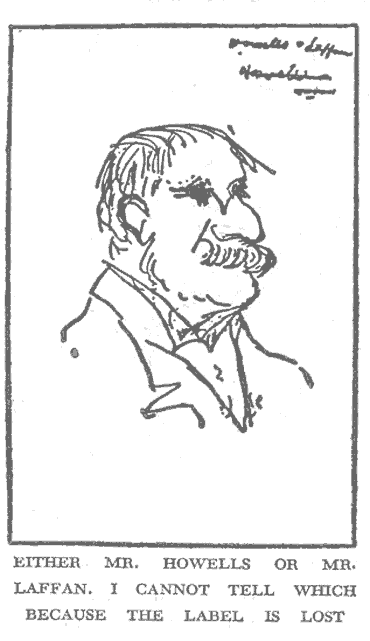
The next picture is part of an animal, but I do not know the name of it. It is not finished. The front end of it went around a corner before I could get to it.
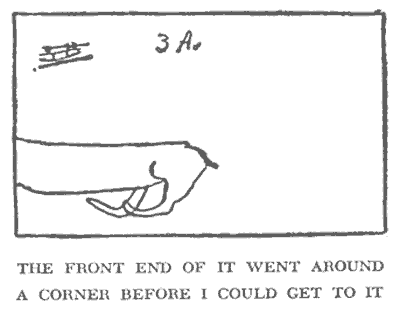
We will conclude with the portrait of a lady in the style of Raphael. Originally I started it out for Queen Elizabeth, but was not able to do the lace hopper her head projects out of, therefore I tried to turn it into Pocahontas, but was again baffled, and was compelled to make further modifications, this time achieving success. By spiritualizing it and turning it into the noble mother of our race and throwing into the countenance the sacred joy which her first tailor-made outfit infuses into her spirit, I was enabled to add to my gallery the best and most winning and eloquent portrait my brush has ever produced.
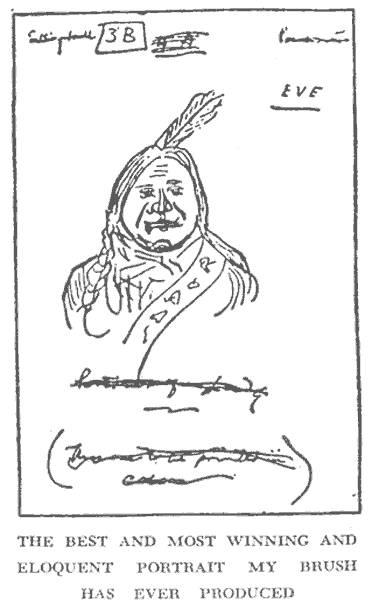
The most effective encouragement a beginner can have is the encouragement which he gets from noting his own progress with an alert and persistent eye. Save up your works and date them; as the years go by, run your eye over them from time to time, and measure your advancing stride. This will thrill you, this will nerve you, this will inspire you as nothing else can.
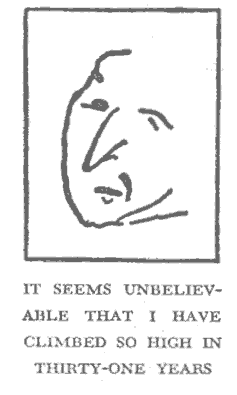
It has been my own course, and to it I owe the most that I am
today in Art. When I look back and examine my first effort and then compare
it with my latest, it seems unbelievable that I have climbed so high in thirty-one
years. Yet so it is. Practice -- that is the secret. From three to seven hours
a day. It is all that is required. The results are sure; whereas indolence
achieves nothing great.

